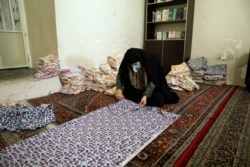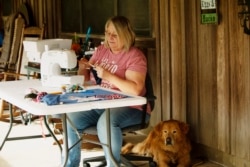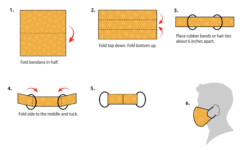From VOA Learning English, this is the Health & Lifestyle report.
Much of the world was caught off guard by the new coronavirus. In many ways and in many places, governments, health care providers and average people were not ready.
Some hospitals, doctors offices and emergency workers found themselves in short supply of personal protective equipment, also called PPE.
Local officials in many parts of the world suggest wearing a face mask in public. A simple cloth face covering can help to slow the spread of the virus. But face masks can be hard to find. High quality ones used by professionals need to be reserved for healthcare workers.
So, people are making their own.
You can make your own cloth face mask from common, household items. To help guide people, the Centers for Disease Control and Prevention (CDC) in the United States has how-to tips on its website.
The website explains that cloth face coverings should do the following:
- fit securely but comfortably around the side of the face
- be secured with ties or ear loops
- include two or more layers of fabric
- permit for easy breathing
- be able to be washed and dried without damage or change to shape
Health officials recommend using 100 percent cotton for a face mask.
But what if I don't know how to sew?
Now, for those people who cannot sew, there are ways to make no-sew face masks. The CDC shows two ways on its website. One uses a cotton t-shirt. The other method uses a coffee filter. (How-to images courtesy of the CDC)
Cotton T-shirt face mask
Here is a step-by-step process for making a face mask from a 100 percent cotton T-shirt. However, if you do not have a 100 percent cotton t-shirt, you can use other materials that are easy-to-find.
You will not need string to tie it around your face if you follow the directions. You will use the T-shirt fabric to make tie “strings.”
Here is what you will need:
- cotton T-shirt
- scissors.
1. First, cut 18 to 20 centimeters from the bottom of the t-shirt. This will leave you with a double-layered rectangle of fabric.
2. Keep the fabric doubled. From only one edge of the fabric, cut out an inner rectangle about 15 to 17 centimeters wide. This will leave the outer edges on the top and bottom as tie strings.
3. Fit the mask securely over your nose and mouth. Tie the fabric “strings” around your neck and over the top of your head.
Bandana & coffee filter face mask
The next face mask uses a bandana or scarf and a common kitchen product – a coffee filter. Here is what you will need:
- a bandana (or a square cotton cloth about 50x50 centimeters)
- a coffee filter
- rubber bands (or hair ties)
- and scissors (if you are cutting your own cloth)
1. First cut the top off of a coffee filter. The one pictured on the CDC website is a cone-shaped filter. But you could use other shapes as well.
2. Lay out your scarf (or bandana) and find the center.
3. Place the cut piece of coffee filter in the center of the folded scarf. Fold the top down. Then fold the bottom up. So, the coffee filter is folded inside the scarf. Now, the scarf is a narrow rectangle.
4. Put rubber bands or hair ties around the scarf rectangle. Place them a little more than 15 centimeters apart.
5. Fold the sides into the middle.Tuck them in so they stay in place.
6. This will make a narrow rectangle with ear loops on either end.
7. Fit the face mask securely over your nose and mouth. Slip the ties (rubber bands or hair ties) over your ears.
How to remove a face mask
Health officials say to remove a face mask from behind. Do not touch the front of the mask. The CDC says to avoid touching your nose, mouth, and eyes. Also, wash your hands immediately after removing it.
Other health experts add that you should store the used mask in a plastic bag and not touch it again until it is cleaned.
How to wash a cloth face mask
The CDC suggests that you wash your masks after each use. CDC experts say that a washing machine should be enough to kill the virus.
However, other health experts say that may not be enough. Some suggest cleaning the masks for 10 minutes in boiling water or in a bleach solution before washing.
If you do not have a washing machine, hand wash with soap and hot water.
Who should not wear cloth face coverings?
Not everyone should wear a face mask. Cloth face coverings should not be placed on young children under age 2. Also, people should not wear a face mask if they have trouble breathing or are unable to remove the mask without help.
Wearing a cloth face mask is not enough.
Wearing a cloth facevmask may reduce the risk of becoming infected with the new coronavirus. However, the CDC and other health organizations give this important warning: Cloth masks should be used with other methods, such as social distancing, handwashing and staying at home.
And that’s the Health & Lifestyle report. I’m Anna Matteo.
Anna Matteo wrote this story for VOA Learning English. Mario Ritter, Jr. was the editor.
________________________________________________________________
Words in This Story
caught off guard expression : to be surprised by something unexpected
tip –n. a piece of advice or useful information
comfortably –adj. done with no physically unpleasant feelings
recommend –v. to suggest that someone do (something)
sew –v. to make or repair something using a needle and thread
fabric –n. a material like a cloth
bleach –n. a strong chemical that is used to make something clean or white
respirator –n. a device worn over the mouth and nose that aids breathing when there is a pollutant in the air
tuck –v. to push the end of (something, such as a piece of cloth or paper) into or behind something in order to hold it in place, make it look neat, etc.














